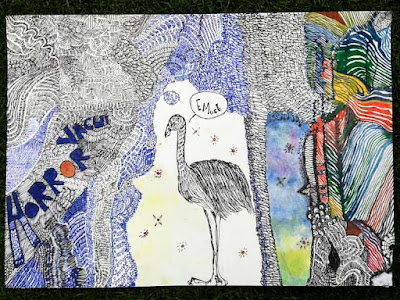Fragmented Observations: An opinion on Art Writing
From the desk of Vitasta Raina
Dated: One afternoon in 2015/16 outside IHC Visual Arts Gallery
 |
| Pen and watercolours. Vitasta, 2015/16 |
I will be honest. I have never studied art, writing, art-writing or the art of writing. But this I know, that I see things, and have the ability to translate my observations and analysis of the things that I see, on paper, and with clarity. Thus, while it is possible for me to frame an opinion about art-writing, it would be one stemming from unfamiliarity, both of the subject of art-writing, as well as its practice. But I do have observations about art, and about writing, and I have somewhat of an understanding of the world that I inhabit, and that which is shared by people; artists, writers and critics alike. Thus, in that respect, I can build a fragmented observation on the nature of art-writing.
From my limited understanding of critical thinking and factual writing, I assess that the process of art-writing is at best dubious. How can you write objectively about a subjective issue? Do you describe the thing in itself, or do you build on its correlations and influences? Thus, do you need to be studied in all forms of the art or facets of the artifact you are describing, or do you need to give the artifact a voice by perhaps describing the journey of the art-maker, or imposing upon it your own sensitivities?
Now coming to the subject of art curation, and gauging by the exhibitions I have seen over the past years at the IHC Visual Arts Gallery (New Delhi) I have made some observations:
1. That taste in art is extrinsic, shaped by the opinions and operations of art galleries and art curators, and not something that is necessarily evocative, but rather provocative.
2. That galleries are expensive real estate paid for by people acquiring a taste for art, and if there are any sales to be made, the glass doors are closed to an unsophisticated public with pens instead of deep pockets.
And now, we speak of ‘Art-writing’ or the ‘Writing on the Walls’ at these great curatorial events, in black block letters, defying basic typographical rules, and sans serif. Always, sans serif! These are the descriptive writings clarifying the esoteric meanings and nuances of the art-work that would otherwise be lost on the philistines that roam through the halls of the gallery at lunch. Yes, I am referring to myself.
The general thumb rule for these wall-letterings, is for it to be a short description by the artist recounting his journey- his own, and that of this art, and a short description by the curator on the artist, the art and the relevance of it all, because in some twisted way, the artwork cannot and must not be for its sake, and like the awkward paragraphs on the wall, must be justified (pun!).
Then there are captions with the art, hanging around the walls, and some even on the floor, like bored animals in zoo enclosures.
Sometimes the artists attach little pieces of poetry to the artwork in an attempt to further elevate the mysteriousness of their work, and of course, to further obscure and alienate the art from its fundamental truth, of just being, at one level a thing of aesthetic value, and on another, if intended, an instrument of some social change.
Anyway, most artists write quite badly, while trying to invoke inner emotions, deep feelings and unknown universal forces. Some of course are direct in their interpretation, others say nothing at all.
In any case, people come and look at the colours, the merger of strokes and the patterns. No one reads. Frankly, it’s boring.
*


Comments
Post a Comment